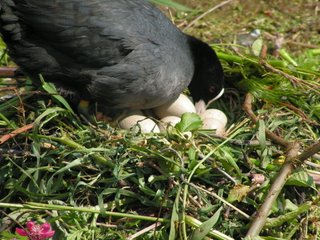Mr Coot brings back some nesting material:

and passes it to Mrs Coot:

Mrs Coot moves her eggs around a little:

and settles down for a spot of incubation:

so that's what discarded supermarket trolleys are for! (click on photos to enlarge)
Coot: Fulica atra. AKA: Common coot, which is all-black and larger than its cousin, the moorhen, it has a distinctive white beak and 'shield' above the beak which earns it the title 'bald'. Coots prefer to live on areas of fairly shallow standing freshwater with a muddy bottom and plenty of vegetation at the sides. Found mainly in lowland areas they eat vegetation, snails and insect larvae.
No comments:
Post a Comment